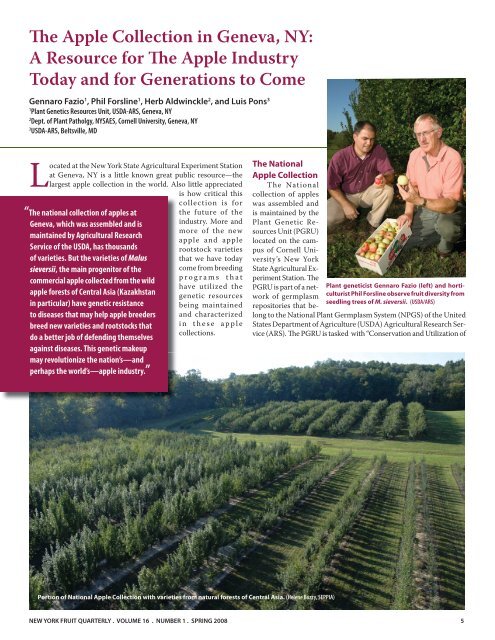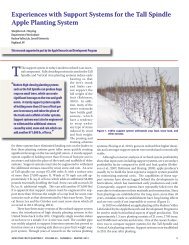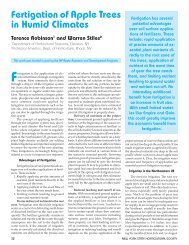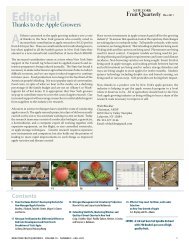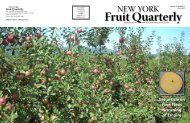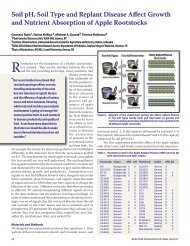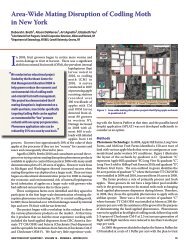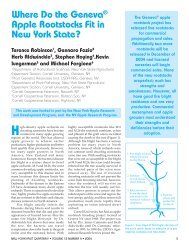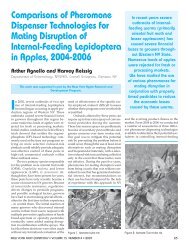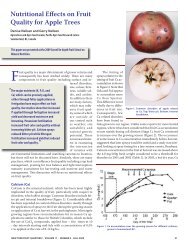The Apple Collection in Geneva, NY - New York State Horticultural ...
The Apple Collection in Geneva, NY - New York State Horticultural ...
The Apple Collection in Geneva, NY - New York State Horticultural ...
You also want an ePaper? Increase the reach of your titles
YUMPU automatically turns print PDFs into web optimized ePapers that Google loves.
<strong>The</strong> <strong>Apple</strong> <strong>Collection</strong> <strong>in</strong> <strong>Geneva</strong>, <strong>NY</strong>:A Resource for <strong>The</strong> <strong>Apple</strong> IndustryToday and for Generations to ComeGennaro Fazio 1 , Phil Forsl<strong>in</strong>e 1 , Herb Aldw<strong>in</strong>ckle 2 , and Luis Pons 31Plant Genetics Resources Unit, USDA-ARS, <strong>Geneva</strong>, <strong>NY</strong>2Dept. of Plant Patholgy, <strong>NY</strong>SAES, Cornell University, <strong>Geneva</strong>, <strong>NY</strong>3USDA-ARS, Beltsville, MDLocated at the <strong>New</strong> <strong>York</strong> <strong>State</strong> Agricultural Experiment Stationat <strong>Geneva</strong>, <strong>NY</strong> is a little known great public resource —thelargest apple collection <strong>in</strong> the world. Also little appreciatedis how critical this“<strong>The</strong> national collection of apples at<strong>Geneva</strong>, which was assembled and isma<strong>in</strong>ta<strong>in</strong>ed by Agricultural ResearchService of the USDA, has thousandsof varieties. But the varieties of Malussieversii, the ma<strong>in</strong> progenitor of thecommercial apple collected from the wildapple forests of Central Asia (Kazakhstan<strong>in</strong> particular) have genetic resistanceto diseases that may help apple breedersbreed new varieties and rootstocks thatdo a better job of defend<strong>in</strong>g themselvesaga<strong>in</strong>st diseases. This genetic makeupmay revolutionize the nation’s—andperhaps the world’s—apple <strong>in</strong>dustry.”collection is forthe future of the<strong>in</strong>dustry. More andmore of the newapple and applerootstock varietiesthat we have todaycome from breed<strong>in</strong>gprograms thathave utilized thegenetic resourcesbe<strong>in</strong>g ma<strong>in</strong>ta<strong>in</strong>edand characterized<strong>in</strong> these applecollections.Plant geneticist Gennaro Fazio (left) and horticulturistPhil Forsl<strong>in</strong>e observe fruit diversity fromseedl<strong>in</strong>g trees of M. sieversii. (USDA/ARS)<strong>The</strong> National<strong>Apple</strong> <strong>Collection</strong><strong>The</strong> Nationalcollection of appleswas assembled andis ma<strong>in</strong>ta<strong>in</strong>ed by thePlant Genetic ResourcesUnit (PGRU)located on the campusof Cornell University’s<strong>New</strong> <strong>York</strong><strong>State</strong> Agricultural ExperimentStation. <strong>The</strong>PGRU is part of a networkof germplasmrepositories that belongto the National Plant Germplasm System (NPGS) of the United<strong>State</strong>s Department of Agriculture (USDA) Agricultural Research Service(ARS). <strong>The</strong> PGRU is tasked with “Conservation and Utilization ofPortion of National <strong>Apple</strong> <strong>Collection</strong> with varieties from natural forests of Central Asia. (Helene Bozzy, SEPPIA)NEW YORK FRUIT QUARTERLY . VOLUME 16 . NUMBER 1 . SPRING 2008 5
A grafted tree produced <strong>in</strong> <strong>Geneva</strong>, <strong>New</strong> <strong>York</strong>,from a scion taken from a tree <strong>in</strong> a Kazakh appleforest. William Srmack, farm manager at <strong>Geneva</strong>,displays the quality fruit of this genotype that haspotential use by breeders. (USDA/ARS)Phil Forsl<strong>in</strong>e and Herb Aldw<strong>in</strong>ckle evaluat<strong>in</strong>g applevarieties from Kazakstan. (Helene Bozzy, SEPPIA)Technician Greg Noden characterizes morphologicaltraits of M. sieversii fruit and cuts the fruit<strong>in</strong> preparation for tak<strong>in</strong>g a digital image for thewebsite www.ars-gr<strong>in</strong>.gov/gen (USDA/ARS)the Genetic Resources of Grapes, <strong>Apple</strong>s, and Tart Cherries.” Intotal, 6,883 diverse apple varieties are ma<strong>in</strong>ta<strong>in</strong>ed at the PGRU.This <strong>in</strong>cludes 2510 apple clones (1,410 Malus x domestica; 329Malus hybrids; and 771 clones belong<strong>in</strong>g to ~54 Malus species)all ma<strong>in</strong>ta<strong>in</strong>ed <strong>in</strong> duplicate field plant<strong>in</strong>gs at <strong>Geneva</strong>. Additionally,1,565 seed lots of wild Malus species <strong>in</strong>clud<strong>in</strong>g approximately950 seed lots of Malus sieversii, the ma<strong>in</strong> progenitor species of thecultivated apple (M. x domestica) from Central Asia are kept <strong>in</strong>cold storage at the PGRU with back ups at the USDA-ARS NationalCenter for Genetic Resources Preservation (NCGRP) <strong>in</strong> Ft. Coll<strong>in</strong>sCO. About 2,808 seedl<strong>in</strong>gs represent<strong>in</strong>g 310 of these M. sieversiiseed lots are be<strong>in</strong>g grown as trees for field evaluation. Of the 6,883apple varieties, a core collection of 255 clones has been designed torepresent the diversity of apple. Furthermore, approximately 2,275clones are backed up <strong>in</strong> cryogenic storage (liquid Nitrogen) at theNCGRP and 436 are also <strong>in</strong> cryogenic storage on-site at PGRU.Most of the varieties used as parents for breed<strong>in</strong>g new varietiesof apples <strong>in</strong> the U.S. come from what is known as the “North Americagene pool.” It dates back to seedl<strong>in</strong>g orchards planted when settlersfirst arrived here between the 17th and 19th centuries. This source isoften referred to as the “Johnny <strong>Apple</strong>seed gene pool.” This alludes toJohn Chapman, who dur<strong>in</strong>g America’s <strong>in</strong>fancy spent nearly 50 yearsplant<strong>in</strong>g apple seeds throughout the wilderness of Pennsylvania,Ohio, Indiana, and Ill<strong>in</strong>ois. Many common varieties—<strong>in</strong>clud<strong>in</strong>gRed Delicious, Golden Delicious, Jonathan, and McIntosh—werediscovered as chance seedl<strong>in</strong>gs from this pool. <strong>Apple</strong> breeders havemade great strides already us<strong>in</strong>g them to produce new ones that arenow <strong>in</strong> the world marketplace. But the fact is that this gene pool isvery narrow compared to what can be found by trac<strong>in</strong>g further back,through Western Europe, to Central Asia where it is thought applesorig<strong>in</strong>ated. Indeed, the mother lode of apple genes is <strong>in</strong> Central Asia—Kazakhstan and Kyrgyzstan <strong>in</strong> particular—which is likely the centerof orig<strong>in</strong> or ancestral home of familiar domestic apples (Malus xdomestica) such as Red Delicious, Golden Delicious, and McIntosh.Widen<strong>in</strong>g a Narrow Base—<strong>Collection</strong> Expeditions toCentral Asia, the <strong>Apple</strong>’s Ancestral HomeSilk Road traders and their predecessors started the spread ofapples from Central Asia to other parts of the world. But the seedsthey carried likely represented a narrow genetic sampl<strong>in</strong>g. That’sprobably why today’s American domestic apples have a fairly narrowgenetic base that makes them susceptible to many diseases.From 1989 to 1996, the USDA sponsored expeditions to CentralAsia to collect seeds and tree samples (scions) from unique applestrees grow<strong>in</strong>g <strong>in</strong> natural forests. Seven expeditions were completedfrom 1989 to 1999. Four of them were to Central Asia to collect thewild apple Malus sieversii, the ma<strong>in</strong> progenitor of the commercialapple, M. x domestica.<strong>The</strong> Experiment Station’s Herb Aldw<strong>in</strong>ckle was a participanton the first trip to Central Asia <strong>in</strong> 1989. Philip Forsl<strong>in</strong>e, who is thecurator of the national apple collection, was a member of seven ofthe trips, <strong>in</strong>clud<strong>in</strong>g four to central Asia to collect apple material,conserve it, and, after evaluation, distribute it to breeders and geneticistsworldwide. Other trips were to Ch<strong>in</strong>a (Sichuan), Russian,and Turkish sectors of the Caucasus region, and Germany. He recallsthe expeditions as hard work. Herb jo<strong>in</strong>ed Phil also on the trips toCh<strong>in</strong>a and Turkey. Often, the only way of gett<strong>in</strong>g to remote mounta<strong>in</strong>areas was by helicopter, long hikes, or half-day-long jeep rides downbumpy, dusty roads. What we collected made possible our re-creationof Kazakhstan, Ch<strong>in</strong>a and the Caucasus region here <strong>in</strong> <strong>Geneva</strong>. Allthat effort is now bear<strong>in</strong>g fruit, literally and scientifically. We tappedmillions of years of adaptations to improve today’s apple.<strong>The</strong> trips resulted <strong>in</strong> at least a doubl<strong>in</strong>g of the known geneticdiversity of apples. In all, the scientists returned from Central Asiawith 949 apple tree accessions. Most of the specimens were broughthere as seed, but 50 were cataloged as “elite clones”—grafts of theorig<strong>in</strong>al trees. <strong>The</strong> seeds gathered on the trips <strong>in</strong>creased PGRU’sapple collection by 1,140 samples, to over 3,900. <strong>The</strong> visits to Kazakhstanand Kyrgyzstan alone added 949 accessions of M. sieversii.6 NEW YORK STATE HORTICULTURAL SOCIETY
Technician Todd Holleran waters young apple rootstock seedl<strong>in</strong>gs that havesurvived the “gauntlet” of disease screens. <strong>The</strong>se disease-resistant seedl<strong>in</strong>gsare derived from a cross between resistant wild M. sieversii selections andelite apple rootstocks from the <strong>Geneva</strong> breed<strong>in</strong>g program. (USDA/ARS)Wild apples from Kazakstan that have “almost” commercial quality. (HeleneBozzy, SEPPIA)Unfortunately many of these natural forests sites are threatenedby over graz<strong>in</strong>g, and <strong>in</strong>sidious human practices (clear<strong>in</strong>g areas foragriculture or construction, graft<strong>in</strong>g forests trees to domesticatedvarieties).Remarkable Kazak <strong>Apple</strong>sAmong all this material, it is the Kazak samples that have becomethe apple of Forsl<strong>in</strong>e’s eye, so to speak. It turns out that thisgene pool is much more diverse than we had orig<strong>in</strong>ally thought.Especially noteworthy are accessions collected there of M. sieversii,an important forerunner of the domestic apple. Although many ofthe Kazak apples lack the size and flavor needed for commercialsuccess, it’s the trees’ ability to resist diseases that sets them apart.Breeders will be able to cross them with palatable varieties to develophigh quality commercial varieties.Success Aga<strong>in</strong>st Plant DiseasesForsl<strong>in</strong>e and Herb Aldw<strong>in</strong>ckle from Cornell University alongwith colleagues from PGRU, and other <strong>in</strong>stitutions have been characteriz<strong>in</strong>gthe trees’ germplasm for the last decade. Germplasm refersto the genetic material that carries the <strong>in</strong>herited characteristicsof an organism. <strong>The</strong> Kazak trees have shown significant resistanceto apple scab, the most important fungal disease of apples, whoseoutbreaks blemish fruit and defoliate trees. Twenty-seven percent ofthe Kazak accessions were resistant to it. This makes sense becausethe tree co-evolved with the disease through natural selection.In addition, samples from species collected at other expeditionsites have provided promis<strong>in</strong>g news <strong>in</strong> the fight aga<strong>in</strong>st fire blight.Fire blight destroys apples, pears, and woody ornamentals <strong>in</strong> theRosaceae family. Herb Aldw<strong>in</strong>ckle reports that seedl<strong>in</strong>gs fromdifferent populations of M. orientalis from the Russian Caucasusand Sichuan regions effectively resisted the disease, with Russianaccessions scor<strong>in</strong>g 50 to 93 percent resistance. Other researchershave found genes <strong>in</strong> these apples that allow them to adapt tomounta<strong>in</strong>ous, near-desert, and cold and dry regions.In an early effort to utilize the natural disease resistance of theKazak trees, Forsl<strong>in</strong>e led a project which <strong>in</strong>volved scientists fromCornell and the University of M<strong>in</strong>nesota, as well as collaboratorsfrom <strong>New</strong> Zealand and South Africa, <strong>in</strong> which the popular Galaapple variety was crossbred with seven Kazak accessions. Thisproduced seven populations of 200 seedl<strong>in</strong>gs each. In one of thesepopulations, we achieved a 67 percent resistance rate aga<strong>in</strong>st applescab. This may be the source of a more durable, scab-resistantapple. Also, about 30 percent of samples <strong>in</strong>oculated with fire blightresisted that disease.Rootstocks, Too<strong>The</strong> fire blight resistance of the Kazak M. sieversii and the RussianM. orientalis may convey resistance to fire blight and less sensitiv-Members of the American Nationalfamily of companiesNEW YORK FRUIT QUARTERLY . VOLUME 16 . NUMBER 1 . SPRING 2008 7
ity to latent virusesthan small-fruitedMalus species. Thiswould be especiallyuseful for breed<strong>in</strong>gfire blight-resistantrootstocks. GennaroFazio, directorof PGRU’s applerootstock breed<strong>in</strong>gproject, sees greatpotential—especiallywith crosses betweenKazak applesand elite Americanmaterial. This is thefuture of the apple<strong>in</strong>dustry <strong>in</strong> anotherfive to seven years.<strong>The</strong> naturalselection that occurs<strong>in</strong> the CentralAsian forests seemsto have helped theKazak trees developresistance to soilpathogens that canotherwise stuntHerb Aldw<strong>in</strong>ckle, plant pathologist from CornellUniversity, observes a susceptible seedl<strong>in</strong>g of M.sieversii <strong>in</strong>oculated with the bacterium (Erw<strong>in</strong>iaamylovora) that causes fire blight. (USDA/ARS)young apple orchards and lead to poor growth and lost production.This material is “a treasure trove” of new genetic variants forresistance to Phytophthora cactorum, which causes collar rot, andRhizoctonia solani, an agent of apple replant disease.<strong>The</strong> progeny of two of the Kazak trees have stood up particularlywell to disease. We put them through what we call “<strong>The</strong> Gauntlet,”which is exposure <strong>in</strong> the greenhouse to a series of pathogens that<strong>in</strong>clude fire blight and Phytophthora. It usually kills 70 to 80 percentof seedl<strong>in</strong>gs. However with this material we got 70 to 80 percent survivalrates. Test of this material by Mark Mazzola of ARS’s Tree FruitResearch Laboratory <strong>in</strong> Wenatchee, Wash<strong>in</strong>gton who specializes<strong>in</strong> soilborne diseases of apples, showed that it is significantly moreresistant to R. solani than the controls he was us<strong>in</strong>g. <strong>The</strong> reduction<strong>in</strong> root mass due to <strong>in</strong>fection was 30 percent, compared to 70 percentfor the controls. We are consider<strong>in</strong>g seek<strong>in</strong>g the <strong>in</strong>heritance of thisresistance by follow<strong>in</strong>g it—and the genes caus<strong>in</strong>g it—<strong>in</strong> the progeniesof these plants. This step will take us closer to clon<strong>in</strong>g and isolat<strong>in</strong>ggenes responsible for this resistance.<strong>The</strong>se seedl<strong>in</strong>gs have already become part of PGRU’s rootstockbreed<strong>in</strong>gprogram. With the aid of marker-assisted selection, theprogeny from these crosses will become the resistant rootstocks ofthe future. Also, root tissue from the survivors of the Phytophthora<strong>in</strong>oculation has been used to create a cDNA library that will besequenced as part of an ongo<strong>in</strong>g National Science Foundation ExpressedSequence Tag project. <strong>The</strong> goal is to f<strong>in</strong>d the genes that areexpressed only <strong>in</strong> resistant <strong>in</strong>dividuals.<strong>The</strong> Future<strong>The</strong> work to further characterize the collection cont<strong>in</strong>ues but<strong>in</strong>creased efforts to utilize the germplasm are underway. <strong>The</strong> goal nowis to release germplasm l<strong>in</strong>es from the collected materials with<strong>in</strong> fiveyears. <strong>The</strong>se collections are now be<strong>in</strong>g offered to breeders to developdiverse and useful hybrids for fruit, ornamental, and rootstock value.Today, it is becom<strong>in</strong>g clear that this collection may have an impact ondomestic apples production that will rival that of John Chapman’s.For while Chapman’s iconic work did much to spread apples acrossNorth America, recent f<strong>in</strong>d<strong>in</strong>gs <strong>in</strong> the wild apple germplasm fromCentral Asia—Kazakhstan <strong>in</strong> particular—have genetic resistance todiseases that may help apple breeders breed new varieties that do abetter job of defend<strong>in</strong>g themselves aga<strong>in</strong>st diseases. And the geneticmakeup of the trees may revolutionize the nation’s—and perhaps theworld’s—apple <strong>in</strong>dustry.AcknowledgementsA version of this article “Remarkable Kazak <strong>Apple</strong>s” was published<strong>in</strong> the January 2006 issue of Agricultural Research magaz<strong>in</strong>e.This research project is part of Plant, Microbial, and Insect GeneticResearch, Genomics, and Genetic Improvement, an ARS NationalProgram (#301) described on the World Wide Web at www.nps.ars.usda.gov.Philip Forsl<strong>in</strong>e is the curator of the National <strong>Apple</strong> <strong>Collection</strong> and is theresearch leader of the USDA-ARS Plant Genetic Resources Unit, on the campusof Cornell University’s <strong>New</strong> <strong>York</strong> <strong>State</strong> Agricultural Experiment Station located<strong>in</strong> <strong>Geneva</strong>, <strong>NY</strong>. Gennaro Fazio is research scientist with the USDA-ARS PlantGenetics Resources Unit located on the Experiment Station Campus. He leadsthe Cornell/USDA apple rootstock breed<strong>in</strong>g and evaluation program. Luis Ponsis a writer with the USDA-Agricultural Research Service Information Staff. HerbAldw<strong>in</strong>ckle is a research professor of plant pathology located at <strong>Geneva</strong>, <strong>NY</strong>, wholeads Cornell’s program on fire blight.8 NEW YORK STATE HORTICULTURAL SOCIETY


